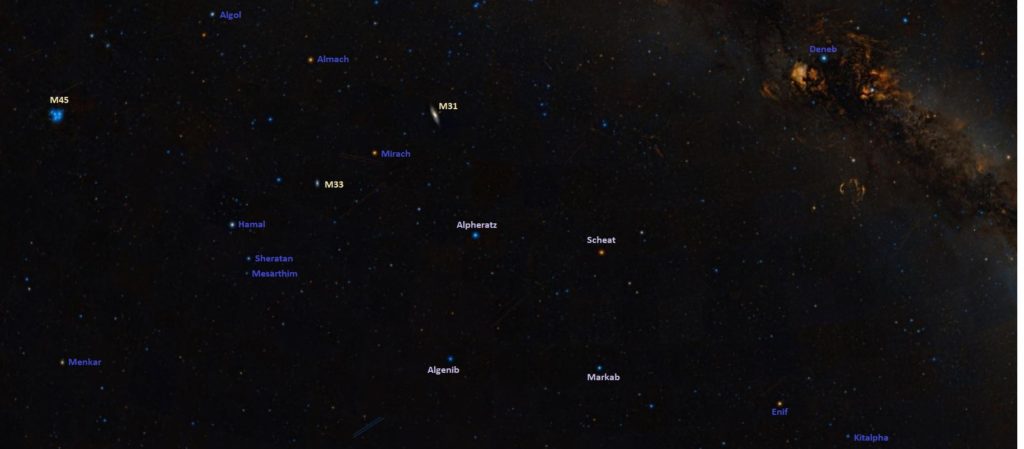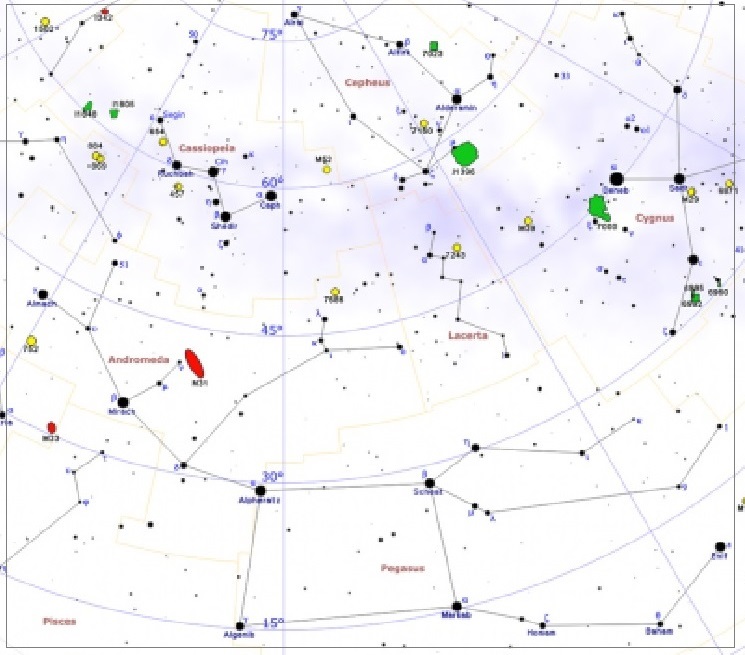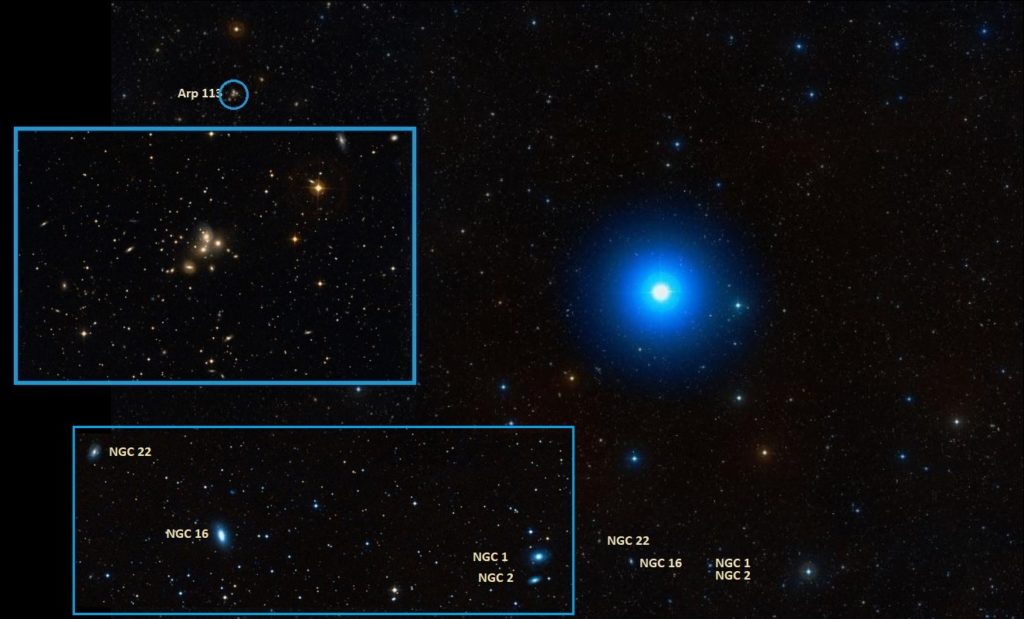Alpheratz, Alpha Andromedae (α And), is a spectroscopic binary star located in the constellation Andromeda. It marks Andromeda’s head. With a combined apparent magnitude of 2.06, it is one of the two brightest stars in the constellation, along with the variable red giant Mirach (Beta Andromedae). Alpheratz lies at a distance of 97 light years from Earth. It is one of the four bright stars that form the Great Square of Pegasus, a conspicuous asterism that outlines the body of Pegasus, the mythical winged horse represented by the neighbouring constellation.
Star system
Alpha Andromedae appears as a single star, both to the unaided eye and in telescopes, but is in fact a single-line spectroscopic binary (SB1) system (a close binary system in which only one stellar spectrum can be observed). The two stars complete an orbit every 96.7015 ± 0.0044 days. The brighter component has an apparent magnitude of 2.22 and the companion, 4.21.
The primary component, formally named Alpheratz, is a blue-white subgiant star of the spectral type B8IVpMnHg. The suffix “p” indicates that the star is chemically peculiar, while the “MnHg” indicates an overabundance of manganese (Mn) and mercury (Hg) in the star’s spectrum.
Alpheratz has a mass 3.8 times that of the Sun and a radius 2.7 times solar. With a surface temperature of 13,800 K, it is 240 times more luminous than the Sun. It has a projected rotational velocity of 52 km/s. Its estimated age is 60 million years.
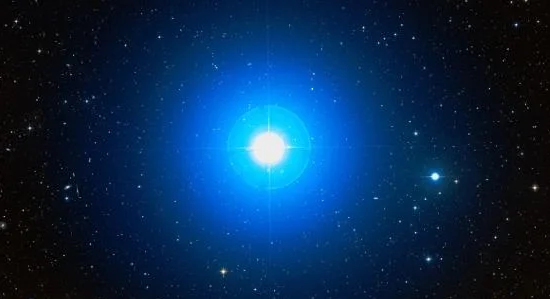
Alpheratz (Alpha Andromedae), image: Wikisky
Alpheratz is the brightest mercury-manganese star in the sky. Its atmosphere has an excess of mercury, manganese, gallium, xenon, and other elements. Mercury-manganese stars are typically slow rotators and have the stellar classification B8, B9 or A0. The elemental abundances are believed to be a result of radiative diffusion, as suggested by Georges Michaud in 1970. The theory proposes that because the stars have very calm atmospheres, some elements sink due to gravitational settling, resulting in underabundances, while others are pushed to the surface by radiation pressure, leading to overabundances.
Other stars of this type include Maia (20 Tauri), one of the brightest stars in the Pleiades cluster, Gienah (Gamma Corvi), the brightest star in the constellation Corvus, Dabih (Beta Capricorni), the second brightest star in Capricornus, and Muliphein (Gamma Canis Majoris).
The companion, Alpha Andromedae B, has the stellar classification A3V, indicating a white main sequence star. The spectral type is estimated based on the star’s brightness relative to the primary component. Alpha Andromedae B has 1.85 solar masses and a radius 1.65 times that of the Sun. With an effective temperature of 8,500 K, it shines with 13 solar luminosities. The star is a fast spinner, with a projected rotational velocity of about 110 km/s. It is believed to be 70 million years old.
The binary system has a visual companion, a class G5 star designated as ADS 94 B in the Aitken Double Star Catalogue and as WDS 00084+2905B in the Washington Double Star Catalog. The companion was discovered by William Herschel on July 21, 1781. It has a visual magnitude of 10.8. However, it is not physically related to the Alpha Andromedae system. It lies at a much greater distance (1,360 light years).
Facts
Before the modern constellation boundaries were defined in 1930, Alpheratz was considered to be part of both Andromeda and Pegasus. Around 270 BCE, the Greek poet Aratus designated the star as xunos aster, “joint star,” i.e. shared by Andromeda and Pegasus. The 2nd century CE Greek astronomer Ptolemy also considered the star to be shared by the two constellations and the German astronomer Johann Bayer (1572 – 1625) assigned it two designations: Alpha Andromedae and Delta Pegasi.
Alpheratz kept its Pegasus membership into the 20th century, when the designation Delta Pegasi finally fell into disuse. Once the constellation boundaries were set, the star was assigned only to Andromeda. A similar thing happened to Elnath, which once belonged both to Taurus and Auriga and had the designations Beta Tauri and Gamma Aurigae. Even though now it belongs only to Taurus, the star is easily recognizable mainly because it is part of Auriga’s conspicuous pentagon asterism.
Alpheratz forms the Great Square of Pegasus with three bright Pegasus stars: Algenib (Gamma Pegasi), Scheat (Beta Pegasi), and Markab (Alpha Pegasi). The asterism dominates the eastern part of the constellation Pegasus and makes it easy to find a number of notable stars and deep sky objects. Alpheratz is the brightest of the four stars, mainly because the other three stars lie at greater distances.
Alpheratz and Mirach (Beta Andromedae) have almost the same apparent magnitude and, since different sources provide slightly different values, both stars have been called Andromeda’s brightest star. Mirach is a red giant whose brightness varies from magnitude 2.01 to 2.10, so on average it is slightly brighter, but not constantly so. It lies at a much greater distance of 197 light years (100 light years farther away than Alpheratz) and it is much more intrinsically luminous. It has a luminosity 1,995 times that of the Sun, while Alpheratz shines with 240 solar luminosities.
Alpheratz is one of the 58 stars that have a special status in the field of celestial navigation. Navigational stars are some of the brightest and best-known stars in the sky. They span 38 constellations and have been selected both because they are exceptionally bright and because they are easy to identify. Alpheratz is recognizable because it is part of the Great Square of Pegasus. It is the only navigational star in Andromeda. Markab, Alpha Pegasi, which lies at the opposite side of the Great Square, is also included on the list.
Variations in the radial velocity of Alpha Andromedae were discovered by the American astronomer Vesto Slipher at the turn of the 20th century. Slipher measured the star’s radial velocity with the Lowell spectrograph from 1902 to 1904 and concluded that the star was a spectroscopic binary system with a highly eccentric orbit and that the components completed an orbit every 100 days or so. The German astronomer Hans Ludendorff gave a preliminary orbit in 1907, and the American astronomer Robert Horace Baker published a more accurate orbit for the system in 1910.
Alpha Andromedae B was first resolved interferometrically by a team led by Xiaopei Pan, an astronomer at the California Institute of Technology, in 1988. The team used the Mark III Stellar Interferometer at the Mount Wilson Observatory in California and determined all orbital parameters. They published their work in January 1992. The spectral lines of the companion were seen in the early 1990s in high-resolution CCD observations made between 1991 and 1994 and published in 1995.
Unusual lines in the spectrum of Alpha Andromedae were first reported by British astronomers Norman Lockyer and F. E. Baxandall in 1906. Baxandall identified them as enhanced manganese lines in 1914, noting that Mu Leporis showed similar lines.
In 1931, American astronomer William Wilson Morgan reported 12 other stars with an excess of manganese in their spectra. In 1975, C. R. Cowley and G. C. L. Aikman identified the stars as part of the group of mercury-manganese stars.
In 1973, Alpheratz was reported to show slight variations in brightness with a period of 0.9636 days, but UVBY photometric observations in the early 1990s found the star not to be a photometric variable.
Observations made between 1993 and 1999 revealed that the mercury line in the star’s spectrum at 398.4 nm varies as the star rotates because the distribution of mercury in the star’s atmosphere is not even. The study, published in 2002, found higher concentrations of mercury near the equator. Subsequent observations, published in 2007, confirmed the variability of the mercury line on a time scale of about 2.38 days and revealed that the clouds of mercury slowly drifted over the star’s surface.
Name
The name Alpheratz (pronunciation: /ælˈfɪəræts/) comes from the Arabic surrat al-faras, meaning “the navel of the horse.” The star’s other traditional name, Sirrah (pronunciation: /ˈsɪrə/), is derived from the same phrase. The reference to the horse reflects the star’s former membership in the constellation Pegasus and the names refer to its position.
In medieval Arabic astronomy, the star was also known as Al Ras al Mar’ah al Musalsalah, meaning “the head of the chained woman.” The name is a reference to the star’s placement in Andromeda, the constellation representing the mythical Greek princess who was chained to a rock and left to the sea monster (Cetus) before being rescued by Perseus.
The name Alpheratz was approved by the International Astronomical Union’s (IAU) Working Group on Star Names (WGSN) on June 30, 2016. It formally applies only to the brighter component of the Alpha Andromedae system.
The Chinese know Alpha Andromedae as 壁宿二 (Bì Sù èr), the Second Star of Wall. The Chinese Wall mansion is formed by Alpheratz and Algenib, Gamma Pegasi. It is one of the seven mansions of the Black Tortoise.
In Hindu astrology, Alpheratz and Algenib form the 26th nakshatra (lunar mansion), known as Uttara Bhādrapadā or Uttṛṭṭāti.
Alpheratz, Algenib and Caph (Beta Cassiopeiae), the rightmost star of Cassiopeia’s W, are known as the Three Guides. They mark the equinoctial colure, the prime meridian of the celestial sphere that passes through the north and south celestial poles and the two equinoxes (vernal and autumnal).
Location
Alpheratz is very easy to find because it is part of a prominent northern asterism. The Great Square of Pegasus can be found using the bright stars that form Cassiopeia’s W. A line extended from Segin, Epsilon Cassiopeiae, through Ruchbah, Delta Cassiopeiae, points in the direction of the asterism.
Alpheratz marks the northeast vertex of the Great Square, appearing in the upper left corner. It is the first in a chain of three stars that stretch from Pegasus to Perseus and make the constellation Andromeda easy to recognize. The middle star in the chain, Mirach (Beta Andromedae) is particularly well-known among stargazers because it is commonly used to find the Milky Way’s largest neighbours: the Andromeda Galaxy (Messier 31) and the Triangulum Galaxy (Messier 33). Almach, the third star in the chain, makes it easy to identify Algol, the famous variable star located in the neighbouring Perseus constellation.
There are several faint deep sky objects that can be seen in the vicinity of Alpheratz. The NGC 68 Group of galaxies, also known as Arp 113 and VV 166, is a cluster of at least 40 galaxies about 300 million light years away. The brightest galaxies in the group appear as a small triangle. The central member, NGC 68, is a lenticular galaxy with an apparent magnitude of 12.9.
The spiral galaxies NGC 1 and NGC 2, the first objects logged in the New General Catalogue, appear close in the sky but are unrelated. The brighter NGC 1 (mag. 13.6) lies at a distance of 211 million light years, while NGC 2 (mag. 15.0) lies 345 million light years away. The lenticular galaxy NGC 16 (mag. 13.0) and spiral galaxy NGC 22 (mag. 14.4) lie in the same field of view.
Alpheratz can be seen from all locations north of the latitude 60° S. For northern observers, it is particularly prominent in the sky in the evenings from August to October. It reaches its highest point in the sky at midnight around October 9.
Constellation
Alpheratz is located in the constellation Andromeda. Representing the mythical princess, daughter of Cassiopeia and Cepheus and wife of Perseus, Andromeda is the 19th largest constellation in the sky. It occupies an area of 722 square degrees between the constellations Perseus, Cassiopeia, Lacerta, Pegasus, Triangulum and Pisces. It is one of the Greek constellations, first listed by the Greek astronomer Ptolemy in the 2nd century CE.
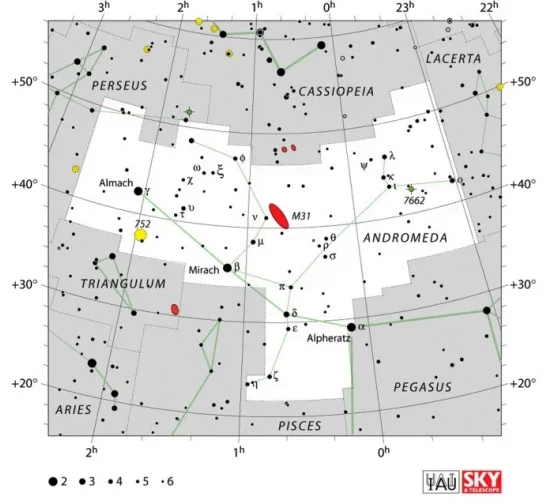
Andromeda constellation map by IAU and Sky&Telescope magazine
Andromeda is best-known for being home to the Andromeda Galaxy (Messier 31), the nearest large galaxy to the Milky Way, with which it will eventually merge. Other notable deep sky objects in the constellation include Andromeda’s smaller satellites Messier 32 and Messier 110, the spiral galaxy NGC 891 (the Silver Sliver Galaxy), the planetary nebula NGC 7662 (the Blue Snowball Nebula), and the bright open star clusters NGC 752 and NGC 7686.
The best time of year to observe the stars and deep sky objects of Andromeda is during the month of November.
The 10 brightest stars in the constellation are Mirach (Beta And, mag. 2.05), Alpheratz (Alpha And, mag. 2.06), Almach (Gamma And, mag. 2.10), Delta Andromedae (mag. 3.28), Nembus (51 And, mag. 3.57), Omicron Andromedae (mag. 3.62), Lambda Andromedae (mag. 3.8), Mu Andromedae (mag. 3.87), Zeta Andromedae (mag. 4.08), and Titawin (Upsilon And, mag. 4.10).
Alpheratz – Alpha Andromedae
| Spectral class | B8IVpMnHg + A3V |
| U-B colour index | −0.46 |
| B-V colour index | −0.11 |
| R-I colour index | −0.10 |
| Apparent magnitude | 2.06 (2.22 + 4.21) |
| Constellation | Andromeda |
| Right ascension | 00h 08m 23.25988s |
| Declination | +29° 05′ 25.5520″ |
| Names and designations | Alpheratz, Sirrah, Alpha Andromedae, α And, Delta Pegasi, δ Peg, 21 Andromedae, HD 358, HR 15, HIP 677, SAO 73765, BD+28°4, GC 127, GCRV 62, FK5 1, ALS 16723, H 5 32A, LTT 10039, NLTT 346, IDS 00032+2832 A, IRAS 00057+2848, PPM 89441, ADS 94 A, CCDM J00083+2905A, WDS 00084+2905A, WDS J00084+2905Aa,Ab, 2MASS J00082326+2905253, TYC 1735-3180-1 |
Alpha Andromedae A
| Spectral class | B8IVpMnHg |
| Apparent magnitude | 2.22 |
| Absolute magnitude | −0.19 ± 0.30 |
| Distance | 97 ± 1 light years (29.7 ± 0.3 parsecs) |
| Parallax | 33.62 ± 0.35 mas |
| Radial velocity | −10.6 ± 0.3 km/s |
| Proper motion | RA: 135.68 mas/yr |
| Dec.: −162.95 mas/yr | |
| Mass | 3.8 ± 0.2 M☉ |
| Luminosity | 240 L☉ |
| Radius | 2.7 ± 0.4 R☉ |
| Temperature | 13,800 K |
| Metallicity | 0.2 |
| Age | 60 million years |
| Rotational velocity | 52 km/s |
| Rotation | 2.38195 days |
| Surface gravity | 3.75 cgs |
Alpha Andromedae B
| Spectral class | A3V |
| Apparent magnitude | 4.21 |
| Absolute magnitude | 2.00 ± 0.30 |
| Mass | 1.85 ± 0.13 M☉ |
| Luminosity | 13 L☉ |
| Radius | 1.65 ± 0.3 R☉ |
| Temperature | 8,500 K |
| Metallicity | 0.2 |
| Age | 70 million years |
| Rotational velocity | 110 ± 5 km/s |
| Surface gravity | 4.0 cgs |
